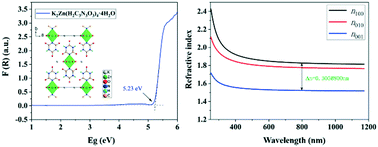Hydroisocyanurates X2Y(H2C3N3O3)4·4H2O (X = K, Cs; Y = Zn, Cd) with large birefringence stemming from π-conjugated (H2C3N3O3)− anions†
Abstract
Birefringent crystals, critical for the polarization of light, play an important role in the optoelectronics field. Herein, by introducing d10 cations into the structures, a family of hydroisocyanurates, X2Y(H2C3N3O3)4·4H2O (X = K, Cs; Y = Zn, Cd) were obtained, which exhibit large birefringence (Δn > 0.25@800 nm) resulting from the π-conjugated (H2C3N3O3)− groups and possess high transmittance (>80%) in the ultraviolet region. In addition, the structure–property relationship was analyzed by first-principles calculations.



 Please wait while we load your content...
Please wait while we load your content...